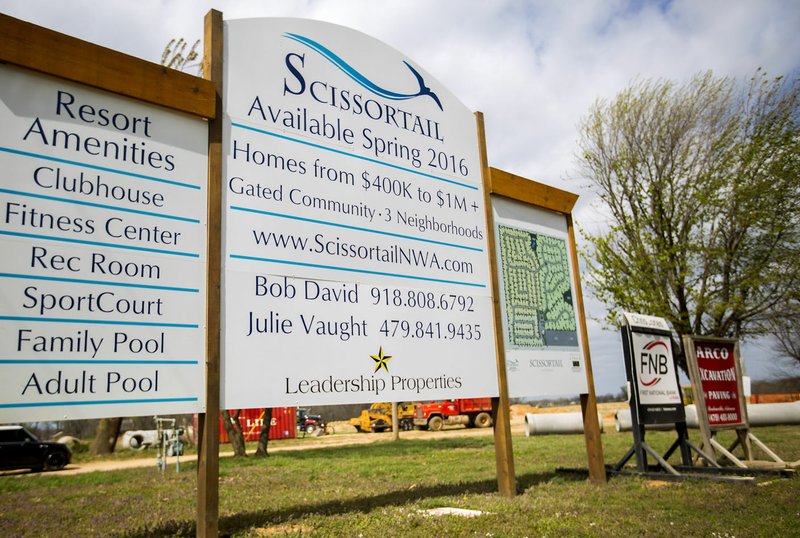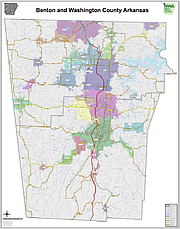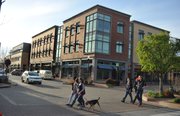People are packing into Northwest Arkansas, leaving few undeveloped places in its core and pressuring even the outlying towns.
The days of mass annexation for most cities have passed, so newcomers squeeze in, increasing the population density. New subdivisions fill areas once inhabited by grazing cattle and green, rolling hills.
Urbanized area
The U.S. Census Bureau measures urbanized areas every 10 years and Northwest Arkansas’ area continues to grow. Jurisdictions in bold were added to the urbanized area in that year.
1990 urbanized area (80 square miles)
Jurisdiction; Population in urbanized area;Percent of urbanized area population
Washington County;162;0.2 percent
Johnson;599;0.8 percent
Greenland;757;1 percent
Farmington;1,322;1.8 percent
Springdale;29,941;40 percent
Fayetteville;42,099;56.2 percent
TOTAL;74,880;100 percent
2000 urbanized area (109 square miles)
Jurisdiction;Population in urbanized area;Percent of urbanized area population
Elm Springs;34;0 percent
Greenland;552;0.3 percent
Bethel Heights;650;0.4 percent
Elkins;722;0.4 percent
Little Flock;1,743;1 percent
Benton County;1,889;1.1 percent
Johnson;1,908;1.1 percent
Washington County;2,145;1.3 percent
Farmington;3,271;1.9 percent
Lowell;4,631;2.7 percent
Bentonville;18,597;10.8 percent
Rogers;35,913;20.8 percent
Springdale;44,397;25.7 percent
Fayetteville;56,133;32.5 percent
TOTAL;172,585;100 percent
2010 urbanized area (188 square miles)
Jurisdiction;Population in urbanized area;Percent of urbanized area population
McDonald County, Mo.;2;0 percent
Prairie Grove;69;0 percent
Tontitown;71;0 percent
Greenland;721;0.2 percent
Cave Springs;969;0.3 percent
Elm Springs;973;0.3 percent
Little Flock;1,742;0.6 percent
Washington County;1,868;0.6 percent
Elkins;1,991;0.7 percent
Bethel Heights;2,359;0.8 percent
Johnson;3,123;1.1 percent
Pea Ridge;4,298;1.5 percent
Farmington;4,964;1.7 percent
Benton County;5,339;1.8 percent
Lowell;6,574;2.2 percent
Centerton;9,135;3.1 percent
Bella Vista;22,841;7.7 percent
Bentonville;33,801;11.5 percent
Rogers;54,897;18.6 percent
Springdale;68,088;23.1 percent
Fayetteville;71,258; 24.2 percent
TOTAL;295,083;100 percent
Source: Northwest Arkansas Regional Planning Commission
On the web
To see maps of the Northwest Arkansas urbanized area and town boundaries go to www.nwadg.com/docum….
"There wasn't a lot out here 20 years ago," said Mike Von Ree, Gravette city clerk, recorder and planner. "I think in the next 20 years there will be no land left in the county."
The increasing density has its advantages and challenges. As the urbanized area grows, it opens the region to additional federal funding opportunities and new options for developers.
But growth also stretches into areas without proper infrastructure, increasing the need for roads and utilities.
Bob David, a partner with Leadership Properties, is experiencing both sides of the coin with his Scissortail subdivision in far western Rogers. The 263-lot subdivision is on 147 acres of former farm land on Haxton Road, west of Arkansas 112. His firm is paying to connect city utilities to the project. The city of Rogers is extending Southgate Road to line up with Haxton, providing a straight route to Interstate 49 for the neighborhood.
"With utilities and access greatly improved, I anticipate there will be several thousand homes of all price ranges out there in the next 10 years," David said. "We saw something and acted on it; not everyone acted on it."
Urbanized areas
Jeff Hawkins, director of the Northwest Arkansas Regional Planning Commission, said there are plenty of places to develop in the region's urbanized areas, particularly between Rogers, west of Scissortail, and the airport.
Urbanized areas must have a population of at least 50,000 people, and they form the core of a metropolitan statistical area. Northwest Arkansas' metropolitan statistical area includes Benton, Washington and Madison counties and McDonald County, Mo.
The U.S. Census Bureau tabulates information to determine urbanized areas every 10 years using a complex formula. The urbanized area in Northwest Arkansas extends from Pea Ridge in the north to Elkins, Greenland and Farmington in the south. It even includes a sliver of Prairie Grove.
"If you look at the map, it's like a comma with the top out by the airport and wrapping around down the interstate," Hawkins said of the urbanized area. "The density also shows us Benton County is becoming urban in character and will eventually have more urbanized area than Washington County."
The Northwest Arkansas urbanized area was entirely in Washington County in 1990, spanning just 80 square miles and including parts of five towns.
It spread into Benton County for the 2000 report, jumping to 109 square miles and including 12 towns.
The most recent data shows it growing to nearly 188 square miles with 18 towns in the two-county area and a small portion of McDonald County, Mo.
"We determined every area was growing in Northwest Arkansas," Hawkins said.
The U.S. Census Bureau released population estimates last week that show Northwest Arkansas reached 513,559 last year, adding about 31 people per day between July 1 of 2014 and 2015. The population has more than doubled since 1990 and grew nearly 8 percent between 2010 and 2014.
The urbanized area is a key factor when it comes to receiving money from the U.S. Federal Highway and Transit administrations and allows cities to qualify for federal Community Development Block Grants.
Hawkins said the area has received nearly $7 million more in federal highway funding since 2013 because of its growing urbanized area.
Having an urbanized area also requires leaders to create additional plans, such as stormwater and transit. The regional planning commission must also create a long-range plan that identifies how the area will look in 20 to 25 years. Population projections for Northwest Arkansas are 648,225 in 2030 and 802,372 in 2040.
The plan is updated every five years and was approved by the commission last week.
Filling in
Municipalities look at how the urbanized area is growing for planning purposes.
Steve Glass, Rogers' director of planning and transportation, said growth in western Rogers made it clear there was a need for better roads. Southgate Road will run along the northern edge of the gated community Shadow Valley and will be a four-lane, divided boulevard. It will line up with Haxton to the west and connect to a widened Pleasant Grove Road to the east.
David said the area west of Arkansas 112 is ripe for development but is hard to access.
Southgate will intersect Arkansas 112, a road Glass described as a rural highway. The Arkansas Highway and Transportation Department is studying improvements to 112 that would widen and straighten the path, helping create another north-south corridor for the region.
"Scissortail helped be a catalyst," said Nathan Becknell, Rogers project engineer. "We needed to get a good connection out there."
David said he hopes the first homes are under construction by October. His group also purchased 40 acres on the northwest corner of Arkansas 112 and Haxton Road and plans to develop denser residential housing with retail facing the highway. He said a grocery store on that corner would be a good fit.
Bentonville Mayor Bob McCaslin said the city has seen a lot of growth in its southwest corridor, which is partly in the urbanized area. He added the downtown continues to be a hot commodity for all types of residential and business ventures.
"I don't know that we have a bad area," he said. "We can continue to grow within."
Growing within
Fayetteville Mayor Lioneld Jordan said it's important for a city to determine its growth boundaries so it can encourage infill development and avoid sprawl.
"The further you go out, the more it costs to provide services," he said.
Infill does bring challenges, he added, such as rehabilitating old water and sewer lines, some that have been around since the turn of the century.
Patsy Christie, Springdale's planning and community development director, said Don Tyson Parkway is helping residents in the eastern part of town connect to commercial developments in the west.
A portion of Springdale south of Watkins Avenue, west of the interstate, falls outside the urbanized area. Watkins Avenue runs along the north side of Arvest Ballpark and will be the southern border of the Arkansas Children's Hospital campus that soon will be under construction.
"Children's Hospital is going to change the complexion of that area," she said. "I think it's going to stir other things and bring other amenities. Personally I think it will have as big of an impact on Springdale as Crystal Bridges had on Bentonville."
Crystal Bridges Museum of American Art opened in November 2011, and many area leaders have pointed to it as a catalyst for development in downtown Bentonville.
Christie said the city received a grant that will punch Don Tyson Parkway through to Arkansas 112, creating another option for motorists.
Not so small
The dense growth can be a mixed bag for smaller communities that often do not have the commercial revenue to help support the services required and desired by new residents.
One town seeing a lot of new residents but not much commercial development is Centerton. The city on the western border of Bentonville grew 17.5 percent from 9,526 in 2010 to 11,193 in 2014. About half of Centerton is in the urbanized area.
"Homes are coming, but one thing our city really falls short on is businesses," said Mayor Bill Edwards.
He said he is working to recruit companies to Centerton. Municipal employment grew from 26 to 52 in the past four years, and Edwards said they still need more people. He said increasing the town's tax base would help pay for services.
A lot of Centerton's residential growth is occurring around Bentonville's new high school, set to open this fall. The school is at 1351 Gamble Road in the northern part of Centerton. Edwards said Bentonville West will be the fifth largest high school in the state and is drawing interest from potential residents.
"We had a lot of land sitting vacant, and now people are coming in and building and subdividing," he said. "All this seems to have happened within the last year because of the high school."
The city also extended its northern boundary when it annexed the Big Sky Subdivision last year on Arkansas 72 and Walters Road, just north of the school. He said it was a voluntary annexation, meaning the property owners wanted to come into the city.
Larry Oelrich, Prairie Grove director of city administrative service and public works, said voluntary annexations are the only type Prairie Grove is doing these days. He said the city annexed a large area in 2006.
"There was a lot of growth on the fringes, and it was control the growth or just let it go. We didn't want to just let it go," he said.
Only the very eastern part of Prairie Grove is in the urbanized area, but Oelrich said growth is happening across the city. Builders are working in eight subdivisions, and the city has processed 40 new residential permits so far this year, he said.
Oelrich joked so much growth can be a negative.
"We enjoy our small-town environment," he said. "I think that is one of the attractions for people moving out here."
Annexed growth
Gravette grew from just two square miles to almost 15 square miles in just over a year after several annexations, including one for the community of Hiwasse, said Von Ree. Residents from Hiwasse opted to become part of Gravette after Bella Vista considered annexing it.
Gravette's border stretches along Arkansas 72 and cradles the southern edge of Bella Vista.
"Right now all we are doing is voluntary annexations," Von Ree said. "We are not aggressive about seeking land. You have to be contiguous to annex anyway."
Charlie Holyfield, city manager of Cave Springs, said he thinks the entire town will soon be considered urbanized. Cave Springs finds itself in an interesting predicament because of a de-annexation in the late 1990s that split the city in half. The de-annexed portion is now in Rogers and home to Scissortail. The law changed in the early 2000s and now de-annexed land has to be contiguous to the city annexing it.
"It's not good for a city to be an island," he said. "There are annexation opportunities for us out west, and we are looking into it. "
NW News on 03/27/2016


